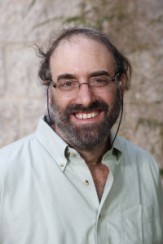Dr. Jeremy Benstein
“Fair moon, to thee I sing, bright regent of the heavens, say, why is everything either at sixes or at sevens?”
– Gilbert and Sullivan, H.M.S. Pinafore, Act II, 1878
While generally on the same page about Jewish observance, my wife and I sometimes differ about particular holidays or rituals. For instance, after the transcendent spiritual high of Yom Kippur, she finds the very material, nature-and-structure focused themes of Sukkot a come-down. And the explicit fertility imagery in the symbols of Sukkot? Less than inspiring: “it’s all so ridiculously pagan!” she’ll protest. I on the other hand, while far from being a mystic, love the tactile and sensual connection to all things natural, and love even more the idea that we successfully weave these seemingly idolatrous motifs into our celebration and worship. “It’s all so deliciously pagan!” I’ll retort.
What fertility imagery is that? For those not familiar with the ritual, it can be described thus: Every day of the seven days of Sukkot, we take a long stiff palm branch, the lulav, together with other leafy greens, and a round fleshy citron, the etrog, and we clasp them together and shake them up and down and back and forth and dance with them, leading up to the prayers for the life-giving liquid of rain on the culmination of the holiday on the special Eighth Day of Assembly, Shemini Atzeret. What can I say? Native Americans ain’t got nothing on us.
This being a shmita year, it struck me that one of the specific rituals that we have with the lulav and etrog actually replicates the rhythm of the shmita cycle. At one point in the service, during the Great Hallel, the psalms of praise, while we are holding our sacred vegetation, we shake them in six different directions – forward and back, right and left, up and down: the six axes of three dimensional space. However, when saying the name of God in the prayer, we are meant to cease movement, holding the minim close to our hearts.
This is the seventh direction, the one that binds all the others together, not an axis of physical space, but the direction of interiority, of the spirit, the meeting of paths that lead to the Center. It is a sort of eye at the center of the storm: that point of calm, of inward focus, the state in which we are cognizant of the “still, small voice” (I Kings 19:12), when after being pulled and shaken in all directions, we are at rest, at one.
The idea of 6 + 1 directions immediately suggests a connection to the Shabbat/shmita cycle of 6+1 days/years. Clearly, we Jews have a thing with sevens: Shabbat is the seventh day, there are seven species of the Land, and we have seven founding personalities of “the nation”: four matriarchs and three patriarchs. The big pilgrimage holiday of Pesach and Sukkot are seven days. Moreover, there is an addition to each of those holidays. Shemini Atzeret is the 7th +1 day, the 8th day from Sukkot- and it is called atzeret like Shavuot- which is seven weeks after Pesach, that is, the 7 x 7th + 1, the 50th day, just as the Yovel, the Jubilee, is the 7 x 7th +1, the 50th year, of the shmita cycle squared.
But while seven is indeed near ubiquitous, there is something a little different specifically about this rhythm of 6+1. There is no real objective basis in nature for the cultural or religious centrality of the number seven. However, it has been noted that six circles or spheres will always self-organize equally around a seventh at the center. The three axes of physical reality each go off in two vectors, making six directions, all organized around and connected at the Center. This is the 6+1 that we experience in the day of Shabbat and the year of shmita: a day, or year, that is meant to have a centering, grounding, and unifying effect (whether internally or communally), after being pulled and shaken in all the myriad directions of the economic and social realities of our lives.
The directions themselves are replete with potential symbolism, all meeting at the Center, the point of connection and reconnection. In short, when you shake that lulav, take a minute to meditate on the following:
- Backward and forward movement calls up images of the unending passage of time – the connection to past and future, of past with future, the intergenerational responsibilities to both progenitors and progeny. We of course stand at the center, in the momentary present, building bridges of sentiment and action between history and memory of what has been, and between dreams and ideals of what yet could be.
- Right and left speak the language of politics, poignantly reminding us of the need to heal the wounds of our fragmented society: between conservative and progressive, between me/in-group/parochial and we/out-group/universal. Nobody sees themselves as an extremist – everybody sees themselves as standing firmly in the Center, surrounded by people and factions who are “overboard” in one direction or the other. As in many areas, we need to expand this Center, building bridges between these poles as well.
- Up and down of course call out the eternal dyads of heaven and earth, transcendence and immanence, spirit and matter. One of the great unifications that we can strive for is to heal the great rift, the insidious dichotomization, between body and soul, our temporal physical selves and our divine intimations of eternity, and bring into alignment our spiritual values and our social and ecological reality.
So this Sukkot, this shmita year, don’t just “release, rethink, renew, and reimagine.” The pastoral produce – myrtles, willows, palm and citron – products of the redolent fecundity of the earth, the transpirational spirit-breath of the air, the radiant energy of the sun, and of the restorative, life-giving waters, of above and below can literally help ground you, and Center yourself in our many worlds and realities. And then, after dancing, chanting, waving and shaking, pause, hush, reflect, and to paraphrase E.M. Forster: “Only re-connect.”
 Dr. Jeremy Benstein is the co-founder of the Sova Project and the co-founder and Deputy Director of the Heschel Center in Tel Aviv, and director of the Center’s Environmental Fellows leadership program. He holds an A.B. degree from Harvard, a master’s degree in Judaic Studies from the Schechter Institute and a doctorate in environmental anthropology from the Hebrew University of Jerusalem. He works extensively in leadership development and capacity building with environmental activists and educators in Israel, and has lectured widely (US, Canada, England, Italy, Spain, Turkey) on Judaism, Israel, and the environment, including the environment as a focus of shared citizenship between Jews and Arabs in Israel. Jeremy’s interests focus on the interplay of religion, culture and values with questions of sustainability, topics he has explored in his book The Way Into Judaism and the Environment (Jewish Lights Publishing, 2006). He writes a weekly column for the Hebrew newspaper Haaretz.com on the Hebrew language, and is recently remarried and lives with his spouse Annabel and their five children in Zichron Yaakov.
Dr. Jeremy Benstein is the co-founder of the Sova Project and the co-founder and Deputy Director of the Heschel Center in Tel Aviv, and director of the Center’s Environmental Fellows leadership program. He holds an A.B. degree from Harvard, a master’s degree in Judaic Studies from the Schechter Institute and a doctorate in environmental anthropology from the Hebrew University of Jerusalem. He works extensively in leadership development and capacity building with environmental activists and educators in Israel, and has lectured widely (US, Canada, England, Italy, Spain, Turkey) on Judaism, Israel, and the environment, including the environment as a focus of shared citizenship between Jews and Arabs in Israel. Jeremy’s interests focus on the interplay of religion, culture and values with questions of sustainability, topics he has explored in his book The Way Into Judaism and the Environment (Jewish Lights Publishing, 2006). He writes a weekly column for the Hebrew newspaper Haaretz.com on the Hebrew language, and is recently remarried and lives with his spouse Annabel and their five children in Zichron Yaakov.
The views expressed on this site do not necessarily reflect the views of The Sova Project or its founding partner organizations. All comments on this site are the responsibility of their writers.



